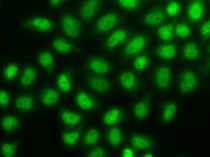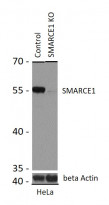ARG59841
anti-SMARCE1 antibody
anti-SMARCE1 antibody for ICC/IF,Immunoprecipitation,Western blot and Human,Mouse,Rat
Overview
| Product Description | Rabbit Polyclonal antibody recognizes SMARCE1 |
|---|---|
| Tested Reactivity | Hu, Ms, Rat |
| Tested Application | ICC/IF, IP, WB |
| Host | Rabbit |
| Clonality | Polyclonal |
| Isotype | IgG |
| Target Name | SMARCE1 |
| Antigen Species | Human |
| Immunogen | Recombinant fusion protein corresponding to aa. 1-411 of Human SMARCE1 (NP_003070.3). |
| Conjugation | Un-conjugated |
| Alternate Names | SWI/SNF-related matrix-associated actin-dependent regulator of chromatin subfamily E member 1; BRG1-associated factor 57; BAF57 |
Application Instructions
| Predict Reactivity Note | Mouse, Rat | ||||||||
|---|---|---|---|---|---|---|---|---|---|
| Application Suggestion |
|
||||||||
| Application Note | * The dilutions indicate recommended starting dilutions and the optimal dilutions or concentrations should be determined by the scientist. | ||||||||
| Positive Control | MCF-7 and U-251MG | ||||||||
| Observed Size | 55 kDa |
Properties
| Form | Liquid |
|---|---|
| Purification | Affinity purified. |
| Buffer | PBS (pH 7.3), 0.02% Sodium azide and 50% Glycerol. |
| Preservative | 0.02% Sodium azide |
| Stabilizer | 50% Glycerol |
| Storage Instruction | For continuous use, store undiluted antibody at 2-8°C for up to a week. For long-term storage, aliquot and store at -20°C. Storage in frost free freezers is not recommended. Avoid repeated freeze/thaw cycles. Suggest spin the vial prior to opening. The antibody solution should be gently mixed before use. |
| Note | For laboratory research only, not for drug, diagnostic or other use. |
Bioinformation
| Database Links | |
|---|---|
| Gene Symbol | SMARCE1 |
| Gene Full Name | SWI/SNF related, matrix associated, actin dependent regulator of chromatin, subfamily e, member 1 |
| Background | The protein encoded by this gene is part of the large ATP-dependent chromatin remodeling complex SWI/SNF, which is required for transcriptional activation of genes normally repressed by chromatin. The encoded protein, either alone or when in the SWI/SNF complex, can bind to 4-way junction DNA, which is thought to mimic the topology of DNA as it enters or exits the nucleosome. The protein contains a DNA-binding HMG domain, but disruption of this domain does not abolish the DNA-binding or nucleosome-displacement activities of the SWI/SNF complex. Unlike most of the SWI/SNF complex proteins, this protein has no yeast counterpart. [provided by RefSeq, Jul 2008] |
| Function | Involved in transcriptional activation and repression of select genes by chromatin remodeling (alteration of DNA-nucleosome topology). Belongs to the neural progenitors-specific chromatin remodeling complex (npBAF complex) and the neuron-specific chromatin remodeling complex (nBAF complex). During neural development a switch from a stem/progenitor to a post-mitotic chromatin remodeling mechanism occurs as neurons exit the cell cycle and become committed to their adult state. The transition from proliferating neural stem/progenitor cells to post-mitotic neurons requires a switch in subunit composition of the npBAF and nBAF complexes. As neural progenitors exit mitosis and differentiate into neurons, npBAF complexes which contain ACTL6A/BAF53A and PHF10/BAF45A, are exchanged for homologous alternative ACTL6B/BAF53B and DPF1/BAF45B or DPF3/BAF45C subunits in neuron-specific complexes (nBAF). The npBAF complex is essential for the self-renewal/proliferative capacity of the multipotent neural stem cells. The nBAF complex along with CREST plays a role regulating the activity of genes essential for dendrite growth (By similarity). Required for the coactivation of estrogen responsive promoters by Swi/Snf complexes and the SRC/p160 family of histone acetyltransferases (HATs). Also specifically interacts with the CoREST corepressor resulting in repression of neuronal specific gene promoters in non-neuronal cells. [UniProt] |
| Cellular Localization | Nucleus. [UniProt] |
| Calculated MW | 47 kDa |
| PTM | Ubiquitinated by TRIP12, leading to its degradation by the proteasome. Ubiquitination is prevented upon interaction between TRIP12 and SMARCC1. [UniProt] |
Images (4) Click the Picture to Zoom In
-
ARG59841 anti-SMARCE1 antibody ICC/IF image
Immunofluorescence: HeLa cells stained with ARG59841 anti-SMARCE1 antibody.
-
ARG59841 anti-SMARCE1 antibody WB image
Western blot: 25 µg of MCF7 and U-251MG cell lysates stained with ARG59841 anti-SMARCE1 antibody at 1:1000 dilution.
-
ARG59841 anti-SMARCE1 antibody IP image
Immunoprecipitation: 150 µg extracts of Jurkat cells immunoprecipitated and stained with ARG59841 anti-SMARCE1 antibody at 1:1000 dilution.
-
ARG59841 anti-SMARCE1 antibody WB image
Western blot: 25 µg of extracts from normal (control) and SMARCE1 knockout (KO) HeLa cells, using ARG59841 anti-SMARCE1 antibody at 1:1000 dilution.









